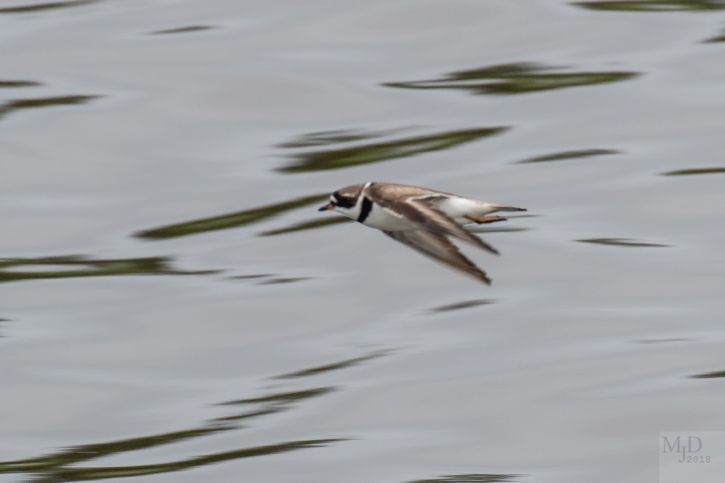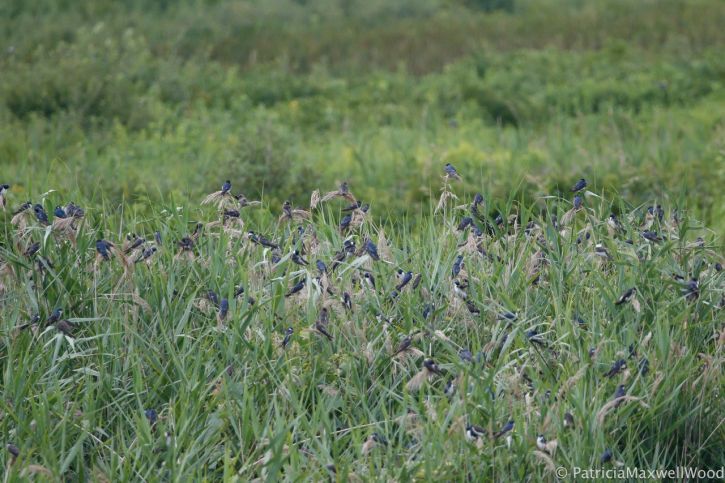August birding outings with Joppa Flats began with a bang last week. Bird life during breeding season in June appears a bit more staid than during the spring migration that precedes it, even though breeding birds are working as hard as they can to hold territories and produce young. The shorebirds mostly disappear, and life on Plum Island slows down. Now we find hundreds or thousands of birds in an excited state once again as the shorebirds kick off the fall migration season. The shorebird migration began building in earnest in the middle of July, so when we resume our weekly outings in August, we are at least two weeks into the shorebirds’ show. On Wednesday, we observed thousands of migrants on Joppa Flats.

Semipalmated Plover – Mike Densmore
We began, as Dave Weaver had suggested, at the Joppa Park boat ramp on Water Street soon after low tide. Not far out in front of us were opportunities to practice distinguishing Greater from Lesser Yellowlegs, with little groups of the birds moving here and there, foraging in the remaining water. We had a great view of one of a pair of Ospreys catching a fish and then being harassed by a Great Black-backed Gull. The Ospreys were foraging very actively, and one flew over with a rather bloody catch.

Osprey harassed by Great Black-backed Gull – Mike Densmore

An Osprey safely bringing home the “bacon” – Patti Wood
The “bar” that becomes exposed at low tide, extending from in front of the boat ramp east to the area off the “clam shack,” did not host very many birds, but at the water’s edge, there is often a site of concentrated bird activity. This week we watched some Bonaparte’s Gulls bobbing high in the water as they do, but sporting sharp black heads still in their breeding plumage. The majority of the birds you see in the list below were far out on the flats, much more to the east toward Plum Island. You could see the Black-bellied Plovers’ field marks in the scope and discern the foraging motion of dowitchers, which we assume to be all or almost-all Short-billed at this early stage of migration. Oftentimes, if you look carefully, you can find a larger godwit out there with its long slightly upturned bill, but not this week. Then there were the thousands of small shorebirds, Semipalmated Plovers and Semipalmated Sandpipers, that were strewn everywhere on the far flats. At that distance, it is simply a pleasure to watch them when they jump up and dash around together in synchronous flight.
Slowing briefly to rejoin our little caravan, we rolled past the Purple Martin colony that Sue McGrath and her volunteers operate at parking lot #1 on Parker River Refuge. Other birds we noticed as we arrived on the island, already moving south, were the first of thousands of Tree Swallows we would find as we drove along the refuge road. We stopped and took photographs at one concentrated roost.

Tree Swallows roosting in Phragmites – Patti Wood
On Wednesday, we found most of the swallows roosting in the Phragmites near North Pool Overlook, but everywhere we went on the island there were swallows, almost all Tree Swallows, moving steadily south. They are one of the few passerines that migrate during the day as they forage for food. Soon, spectacular clouds and even swirling vortices of Tree Swallows will inexplicably form from the hundreds of thousands of them that will eventually gather on Plum Island. Don’t miss that show! Along with the swallows at the overlook, one Least Sandpiper and a group of Gadwalls were using the flats on the far side.

Least Sandpiper – Patti Wood
After peeking at the pools and pannes north of Hellcat, we went straight to Stage Island Pool to see if there would be any shorebirds there. We did see the usual groups of Greater Yellowlegs foraging together there, and hundreds of Tree Swallows sitting on the far flats, but not too much else besides some lovely Snowy and Great Egrets.
With a bit of time to spare, we went to Sandy Point, where the sand has been moving around in large quantities since spring. Sanderlings, many still in alternate or “breeding” plumage, ran on the sand flats. We eventually found a couple of Piping Plovers, but we didn’t walk all the way to their main breeding site up the inlet to Plum Island Sound, where there may be more. We could see lots of Least Terns coming and going from the colony in the same area, carrying food presumably to feed young.

Sanderling – John Linn
Lastly, we went to the dike overlooking Bill Forward Pool at Hellcat, where we saw scores of shorebirds. The same mix we had seen from Joppa Park, with a higher proportion of plovers and dowitchers, foraged in the water and on the flats in front of the blind. We found one White-rumped Sandpiper, and thought we had a few Stilt Sandpipers, before all the birds were suddenly flushed by something, leaving the latter birds off the list.

Short-Billed-Dowitcher – John Linn
This was a nice start to the shorebird season, with our Wednesday evening outing added to the mix. That evening we greatly enjoyed an extended show of the “bouncy walk” of an American Woodcock along the refuge road, and the light on the birds in Bill Forward Pool was fantastic. As we left at 7:15 pm, many egrets were coming in to roost, something we look forward to in the post-breeding dispersal.
Our list:
Joppa Park boat ramp —
American Black Duck (2)
Mallard (~30)
Double-crested Cormorant (~ 12)
Great Egret (1)
Turkey Vulture (2)
Osprey (2)
Black-bellied Plover (~30)
Semipalmated Plover – common.
Greater Yellowlegs (~15)
Lesser Yellowlegs (~30)
Ruddy Turnstone (1)
Semipalmated Sandpiper (~ 1,000+)
Short-billed Dowitcher (~15)
Bonaparte’s Gull (~ 30)
Ring-billed Gull – common.
Herring Gull – common.
Great Black-backed Gull (~5)
Least Tern (2)
Common Tern (~ 12)
Common Grackle
House Sparrow
Plum Island —
Gadwall (7) – adults + juveniles; North Pool Overlook.
American Black Duck (2) – North Pool Overlook.
Mallard – common.
Double-crested Cormorant (5)
Great Egret (~8) – various.
Snowy Egret (1) – small pannes.
Osprey (3) – 1, tripod s. side Cross Farm Hill; 2, vicinity Pines Trail
platform.
Red-tailed Hawk (1) – ad. perched town marker North Pool dike.
Black-bellied Plover (~30) – Bill Forward Pool.
Semipalmated Plover – a few Sandy Point; many, Bill Forward Pool.
Piping Plover (2) – Sandy Point.
Killdeer (1) – Stage Island Pool.
Greater Yellowlegs (~40) – Bill Forward Pool.
Lesser Yellowlegs (~10) – Bill Forward Pool.
Sanderling (~ 15) – Sandy Point.
Semipalmated Sandpiper – a few Sandy Point; many, Bill Forward Pool.
Least Sandpiper (1) – small pannes.
White-rumped Sandpiper (1) – Bill Forward Pool.
Short-billed Dowitcher (~ 47) – 7, North Pool Overlook; ~ 40, Bill Forward Pool.
Least Tern (~30) – Sandy Point.
Common Tern (1) – main panne.
Eastern Kingbird – common.
Purple Martin (~ 12) – vicinity parking lot #1.
Tree Swallow – common
Cliff Swallow (1)
Barn Swallow(~5)
Marsh Wren (1) – Hellcat dike.
American Robin (3)
Gray Catbird (~7)
Northern Mockingbird (2)
Brown Thrasher (1)
European Starling – common.
Cedar Waxwing – common.
Yellow Warbler (3)
Eastern Towhee (2)
Song Sparrow (2)
Common Grackle (~10)
American Goldfinch (4)

